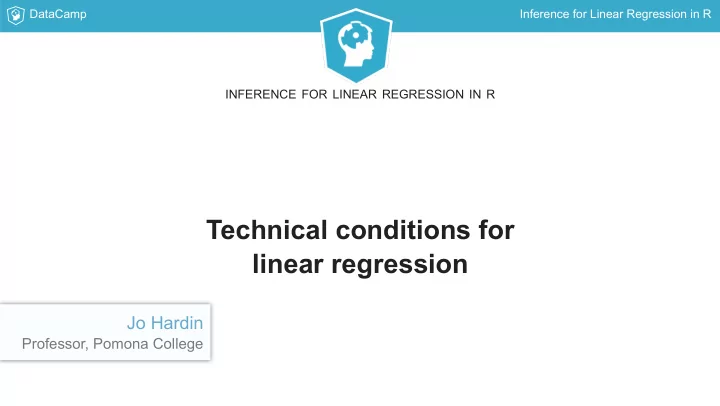

DataCamp Inference for Linear Regression in R INFERENCE FOR LINEAR REGRESSION IN R Technical conditions for linear regression Jo Hardin Professor, Pomona College
DataCamp Inference for Linear Regression in R What are the technical conditions? Y = β + β ⋅ X + ϵ 0 1 ϵ ∼ N (0, σ ) ϵ L: linear model I: independent observations N: points are normally distributed around the line E: equal variability around the line for all values of the explanatory variable
DataCamp Inference for Linear Regression in R Linear model: residuals linear_lm <- augment( lm(response ~ explanatory, data = lineardata) ) ggplot(linear_lm, aes(x =. fitted, y = .resid)) + geom_point() + geom_hline(yintercept=0) ^ i fitted value: = b + b X Y 0 1 i ^ i residual: e = Y − Y i i
DataCamp Inference for Linear Regression in R Not linear Y = β + β ⋅ X + ϵ 0 1 ϵ ∼ N (0, σ ) ϵ L: linear model I: independent observations N: points are normally distributed around the line E: equal variability around the line for all values of the explanatory variable
DataCamp Inference for Linear Regression in R Not linear: residuals nonlinear_lm <- augment( lm(response ~ explanatory, data = nonlineardata) ) ggplot(nonlinear_lm, aes(x = .fitted, y = .resid)) + geom_point() + geom_hline(yintercept=0) ^ i fitted value: = b + b X Y 0 1 i ^ i residual: e = Y − Y i i
DataCamp Inference for Linear Regression in R Not normal Y = β + β ⋅ X + ϵ 0 1 ϵ ∼ N (0, σ ) ϵ L: linear model I: independent observations N: points are normally distributed around the line E: equal variability around the line for all values of the explanatory variable
DataCamp Inference for Linear Regression in R Not normal: residuals nonnormal_lm <- augment( lm(response ~ explanatory, data = nonnormaldata) ) ggplot(nonnormal_lm, aes(x = .fitted, y = .resid)) + geom_point() + geom_hline(yintercept = 0) ^ i fitted value: = b + b X Y 0 1 i ^ i residual: e = Y − Y i i
DataCamp Inference for Linear Regression in R Not equal variance Y = β + β ⋅ X + ϵ 0 1 ϵ ∼ N (0, σ ) ϵ L: linear model I: independent observations N: points are normally distributed around the line E: equal variability around the line for all values of the explanatory variable
DataCamp Inference for Linear Regression in R Not equal variance: residuals nonequal_lm <- augment( lm(response ~ explanatory, data = nonequaldata) ) ggplot(nonequal_lm, aes(x = .fitted, y = .resid)) + geom_point() + geom_hline(yintercept = 0) ^ i fitted value: = b + b X Y 0 1 i ^ i residual: e = Y − Y i i
DataCamp Inference for Linear Regression in R INFERENCE FOR LINEAR REGRESSION IN R Let's practice!
DataCamp Inference for Linear Regression in R INFERENCE FOR LINEAR REGRESSION IN R Effect of an outlier Jo Hardin Professor, Pomona College
DataCamp Inference for Linear Regression in R
DataCamp Inference for Linear Regression in R Different regression lines
DataCamp Inference for Linear Regression in R
DataCamp Inference for Linear Regression in R Different regression models starbucks_lowFib <- starbucks %>% filter(Fiber < 15) lm(Protein ~ Fiber, data = starbucks) %>% tidy() # term estimate std.error statistic p.value # 1 (Intercept) 7.526138 0.9924180 7.583637 1.101756e-11 # 2 Fiber 1.383684 0.2451395 5.644476 1.286752e-07 lm(Protein ~ Fiber, data = starbucks_lowFib) %>% tidy() # term estimate std.error statistic p.value # 1 (Intercept) 6.537053 1.0633640 6.147521 1.292803e-08 # 2 Fiber 1.796844 0.2995901 5.997675 2.600224e-08
DataCamp Inference for Linear Regression in R Different regression randomization tests FULL DATA SET LOW FIBER DATA SET perm_slope %>% mutate( perm_slope_lowFib %>% mutate( abs_perm_slope = abs(stat) abs_perm_slope = abs(stat) ) %>% ) %>% summarize( summarize( p_value = mean( p_value = mean( abs_perm_slope > abs(obs_slope) abs_perm_slope > ) abs(obs_slope_lowFib) ) ) ) # A tibble: 1 x 1 # A tibble: 1 x 1 # p_value # p_value # <dbl> # <dbl> # 1 0 # 1 0
DataCamp Inference for Linear Regression in R INFERENCE FOR LINEAR REGRESSION IN R Let's practice!
DataCamp Inference for Linear Regression in R INFERENCE FOR LINEAR REGRESSION IN R Moving forward when model assumptions are violated Jo Hardin Professor, Pomona College
DataCamp Inference for Linear Regression in R Linear Model Y = β + β ⋅ X + ϵ 0 1 where ϵ ∼ N (0, σ ) ϵ
DataCamp Inference for Linear Regression in R Transforming the explanatory variable 2 Y = β + β ⋅ X + β ⋅ X + ϵ , where ϵ ∼ N (0, σ ) 0 1 2 ϵ Y = β + β ⋅ ln( X ) + ϵ , where ϵ ∼ N (0, σ ) 0 1 ϵ 1 √ Y = β + β ⋅ + ϵ , where ϵ ∼ N (0, σ ) X 0 ϵ
DataCamp Inference for Linear Regression in R Squaring the explanatory variable ggplot(data=data_nonlinear, ggplot(data=data_nonlinear, aes(x=explanatory, y=response)) + aes(x=explanatory^2, y=response))+ geom_point() geom_point()
DataCamp Inference for Linear Regression in R Transforming the response variable 2 = β + β ⋅ X + ϵ , where ϵ ∼ N (0, σ ) Y 0 1 ϵ ln( Y ) = β + β ⋅ X + ϵ , where ϵ ∼ N (0, σ ) 0 1 ϵ √ ( Y ) = β + β ⋅ X + ϵ , where ϵ ∼ N (0, σ ) 0 1 ϵ
DataCamp Inference for Linear Regression in R A natural log transformation ggplot(data=data_nonnorm, ggplot(data=data_nonnorm, aes(x=explanatory, y=response)) + aes(x = explanatory, geom_point() y = log(response))) + geom_point()
DataCamp Inference for Linear Regression in R INFERENCE FOR LINEAR REGRESSION IN R Let's practice!
Recommend
More recommend